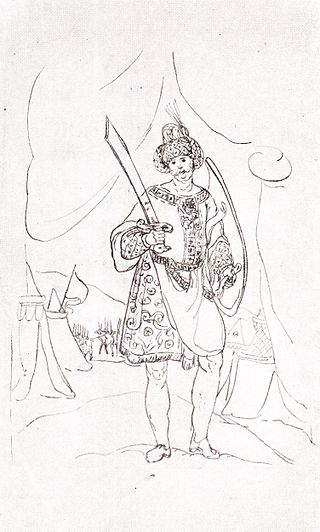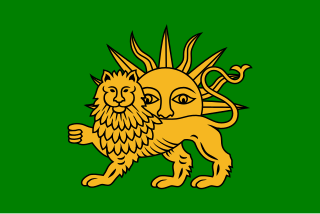Iranian Georgians or Persian Georgians are Iranian citizens who are ethnically Georgian, and are an ethnic group living in Iran. Today's Georgia was a subject of Iran in ancient times under the Achaemenid and Sassanian empires and from the 16th century till the early 19th century, starting with the Safavids in power and later Qajars. Shah Abbas I, his predecessors, and successors, relocated by force hundreds of thousands of Christian, and Jewish Georgians as part of his programs to reduce the power of the Qizilbash, develop industrial economy, strengthen the military, and populate newly built towns in various places in Iran including the provinces of Isfahan, Mazandaran and Khuzestan. A certain number of these, among them members of the nobility, also migrated voluntarily over the centuries, as well as some that moved as muhajirs in the 19th century to Iran, following the Russian conquest of the Caucasus. The Georgian community of Fereydunshahr have retained their distinct Georgian identity to this day, despite adopting certain aspects of Iranian culture such as the Persian language.

Gilan province is one of the 31 provinces of Iran, in the northwest of the country. Its capital is the city of Rasht. The province lies along the Caspian Sea, in Iran's Region 3, west of the province of Mazandaran, east of the province of Ardabil, and north of the provinces of Zanjan and Qazvin. It borders Azerbaijan in the north.

Kakheti is a region (mkhare) formed in the 1990s in eastern Georgia from the historical province of Kakheti and the small, mountainous province of Tusheti. Telavi is its administrative center. The region comprises eight administrative districts: Telavi, Gurjaani, Qvareli, Sagarejo, Dedoplistsqaro, Signagi, Lagodekhi and Akhmeta.

The Karabakh Khanate was a khanate under Iranian and later Russian suzerainty, which controlled the historical region of Karabakh, now divided between modern-day Armenia and Azerbaijan. In terms of structure, the Karabakh Khanate was a miniature version of Iranian kingship. The administrative and literary language in Karabakh until the end of the 19th century was Persian, with Arabic being used only for religious studies, despite the fact that most of the Muslims in the region spoke a Turkic dialect.

Mohammad-Ali Mirza Dowlatshah was a famous Iranian Prince of the Qajar dynasty. He is also the progenitor of the Dowlatshahi family of Persia. He was born at Nava, in Mazandaran, a Caspian province in the north of Iran. He was the first son of Fath-Ali Shah, the second Qajar king of Persia, and Ziba-Chehr Khanum, a Georgian girl of the Tsikarashvili family. He was also the elder brother of Abbas Mirza. Dowlatshah was the governor of Fars at age 9, Qazvin and Gilan at age 11, Khuzestan and Lorestan at age 16, and Kermanshah at age 19.

Qizilbash or Kizilbash were a diverse array of mainly Turkoman Shia militant groups that flourished in Azerbaijan, Anatolia, the Armenian highlands, the Caucasus, and Kurdistan from the late 15th century onwards, and contributed to the foundation of the Safavid dynasty in early modern Iran.

The Hotak dynasty was an Afghan monarchy founded by Ghilji Pashtuns that briefly ruled portions of Iran and Afghanistan during the 1720s. It was established in April 1709 by Mirwais Hotak, who led a successful rebellion against the declining Persian Safavid empire in the region of Loy Kandahar in what is now southern Afghanistan.
The Battle of Marabda took place on 30 June 1625, or July 1, 1625, when the Iranian Safavid army defeated a Georgian force. This battle occurred after the Battle of Martqopi in the same year, when the Iranian army was routed.

Rostom or Rustam Khan was a Georgian royal, from the House of Bagrationi, who functioned as a Safavid-appointed vali /king (mepe) of Kartli, eastern Georgia, from 1633 until his death.

The history of Azerbaijan is understood as the history of the region now forming the Republic of Azerbaijan. Topographically, the land is contained by the southern slopes of the Caucasus Mountains in the north, the Caspian Sea in the east, and the Armenian Highlands in the west. In the south, its natural boundaries are less distinct, and here the country merges with the Iranian Plateau.

Ahar is a city in the Central District of Ahar County, East Azerbaijan province, Iran, serving as capital of both the county and the district. Ahar was the capital of Karadag Khanate in 18th and 19th centuries.
Iran and Georgia have had relations for thousands of years. Eastern and Southern Georgia had been under intermittent Persian suzerainty for many centuries up to the early course of the 19th century, while western Georgia had been under its suzerainty for much shorter periods of time throughout history. Georgia especially rose to importance from the time of the Persian Safavids.

Islam in Georgia was introduced in 654 when an army sent by the Third Caliph of Islam, Uthman, conquered Eastern Georgia and established Muslim rule in Tbilisi. Currently, Muslims constitute approximately 9.9% of the Georgian population. According to other sources, Muslims constitute 10-11% of Georgia's population.
Rostam Khan or Rostom-Khan Saakadze was a high-ranking Safavid military commander and official of Georgian origin. He held the position of commander-in-chief (sepahsalar) under the Safavid shahs, Abbas I and Safi. In 1643, he was accused of treason and executed under king Abbas II. He features in the contemporary Persian and Georgian chronicles and is also a subject of the 17th-century Persian biography written by a certain Bijan for Rostam Khan's grandson, his namesake and a high-ranking officer in Iran.

The Guarded Domains of Iran, commonly called Safavid Iran, Safavid Persia or the Safavid Empire, was one of the largest and long-standing Iranian empires. It was ruled from 1501 to 1736 by the Safavid dynasty. It is often considered the beginning of modern Iranian history, as well as one of the gunpowder empires. The Safavid Shāh Ismā'īl I established the Twelver denomination of Shīʿa Islam as the official religion of the empire, marking one of the most important turning points in the history of Islam.

The Derbent Khanate was a Caucasian khanate that was established in Afsharid Iran. It corresponded to southern Dagestan and its center was at Derbent.
Jesse, also known as 'Isa Khan Gorji was a Georgian prince of the royal house of Kakheti, whose career flourished in the service of the Safavid dynasty of Iran and included several years as a governor of Shaki in what is today Azerbaijan.

The Guarded Domains of Iran, alternatively the Sublime State of Iran and commonly called Qajar Iran, Qajar Persia or the Qajar Empire, was the Iranian state under the rule of the Qajar dynasty, which was of Turkic origin, specifically from the Qajar tribe, from 1789 to 1925. The Qajar family took full control of Iran in 1794, deposing Lotf 'Ali Khan, the last Shah of the Zand dynasty, and re-asserted Iranian sovereignty over large parts of the Caucasus. In 1796, Agha Mohammad Khan Qajar seized Mashhad with ease, putting an end to the Afsharid dynasty. He was formally crowned as Shah after his punitive campaign against Iran's Georgian subjects.

The province of Georgia was a velayat (province) of Safavid Iran located in the area of present-day Georgia. The territory of the province was principally made up of the two subordinate eastern Georgian kingdoms of Kartli and Kakheti and, briefly, parts of the Principality of Samtskhe. The city of Tiflis was its administrative center, the base of Safavid power in the province, and the seat of the rulers of Kartli. It also housed an important Safavid mint.
Iranian Kurdistan or Eastern Kurdistan is an unofficial name for the parts of northwestern Iran with either a majority or sizable population of Kurds. Geographically, it includes the West Azerbaijan Province, Kurdistan Province, Kermanshah Province, Ilam Province and parts of Hamadan Province and Lorestan Province.













